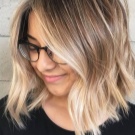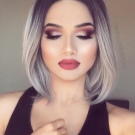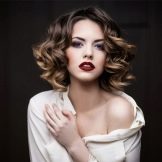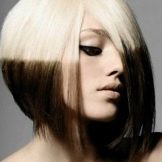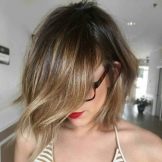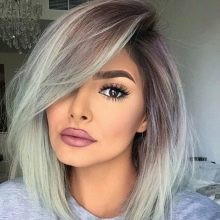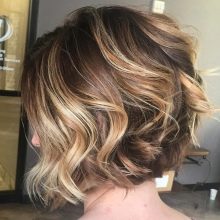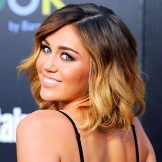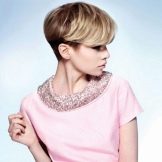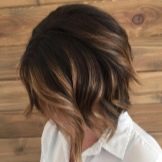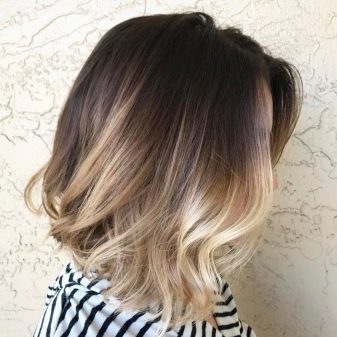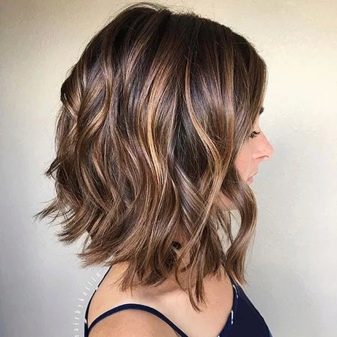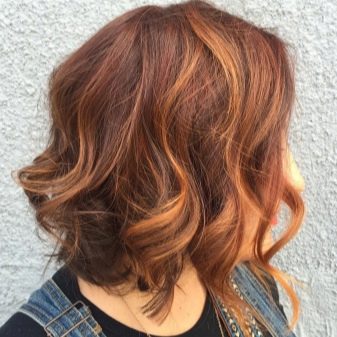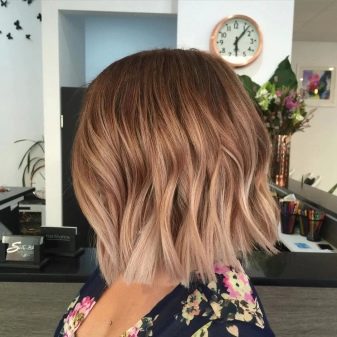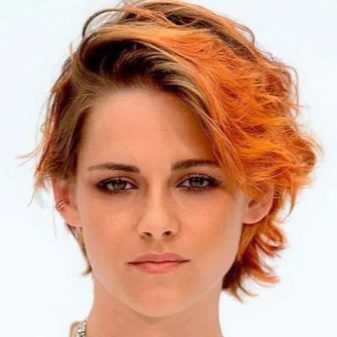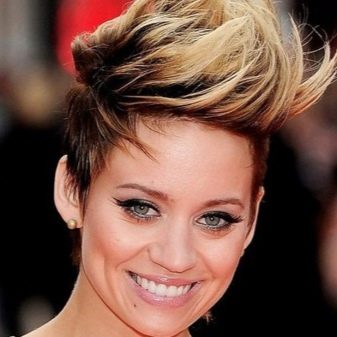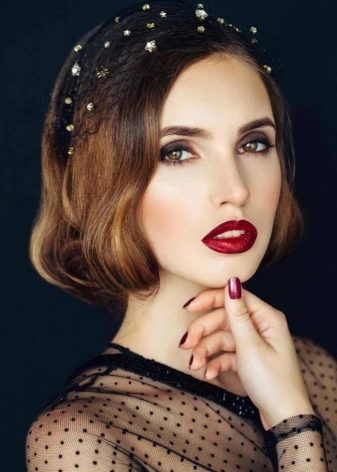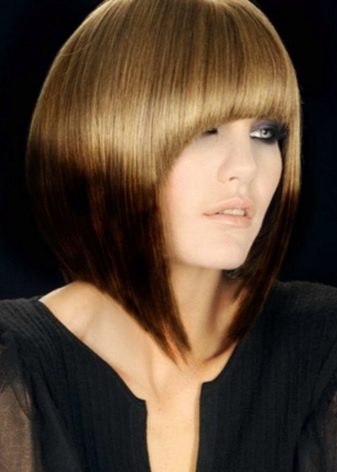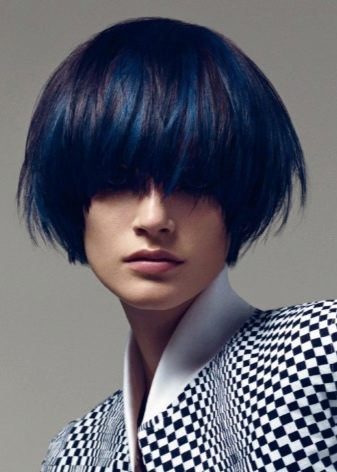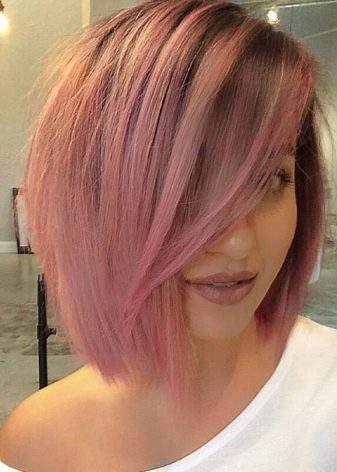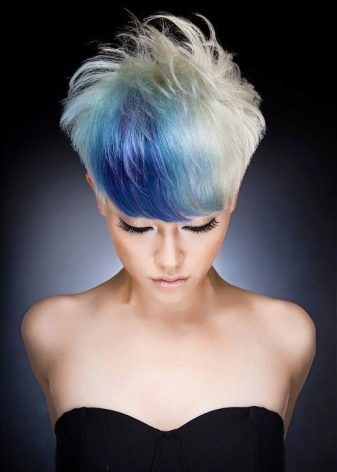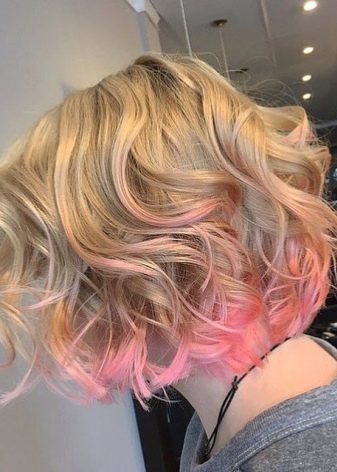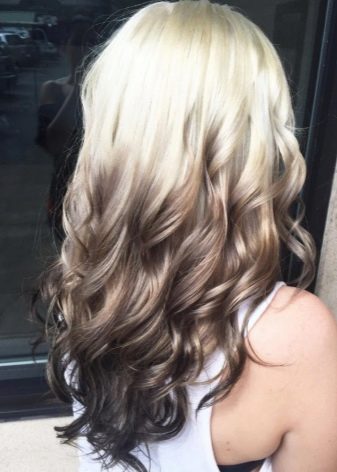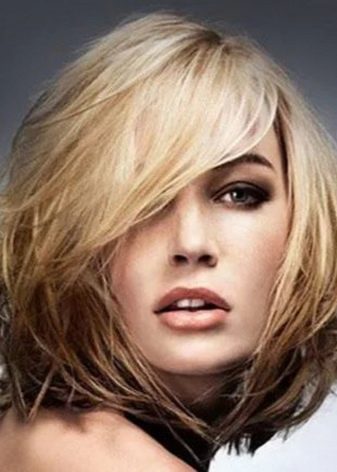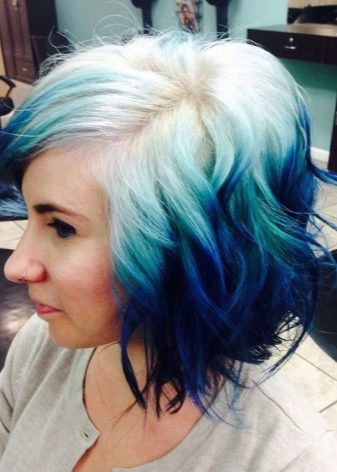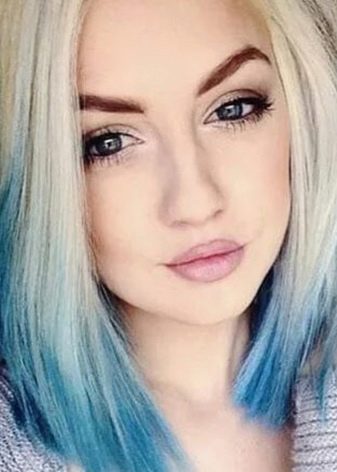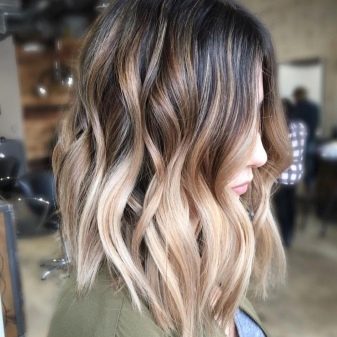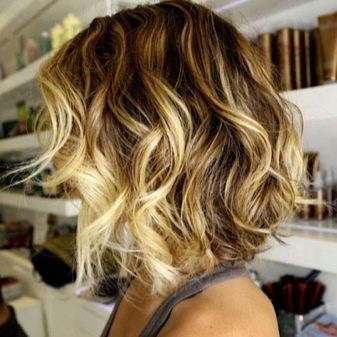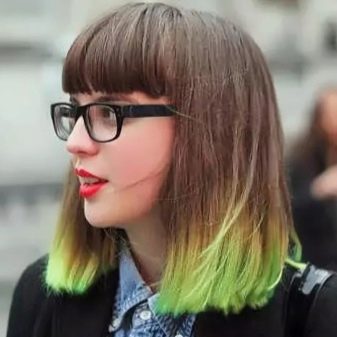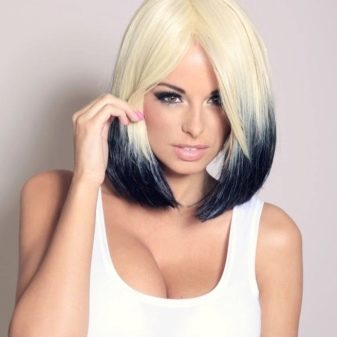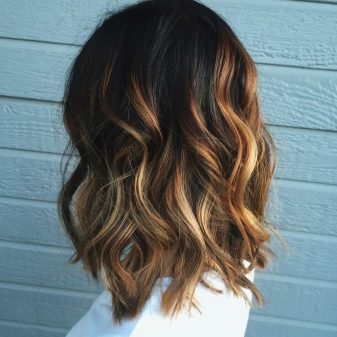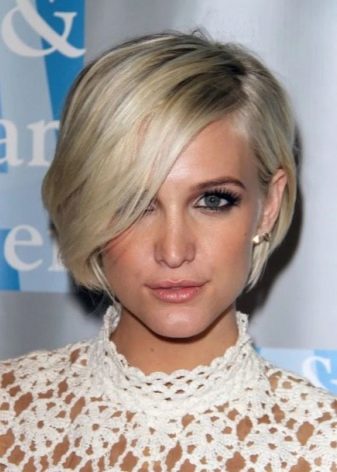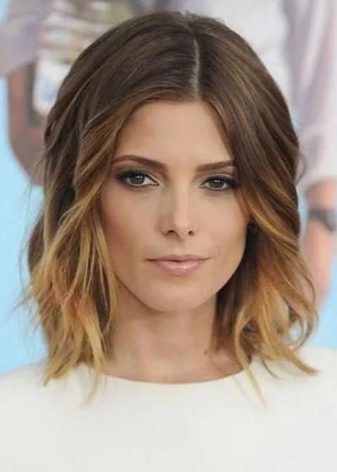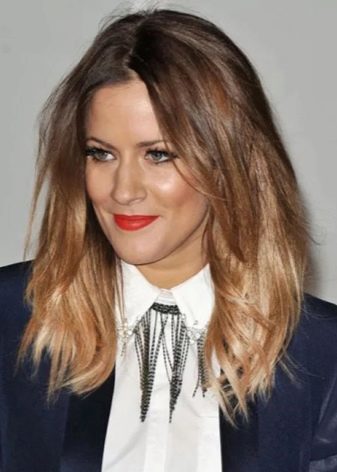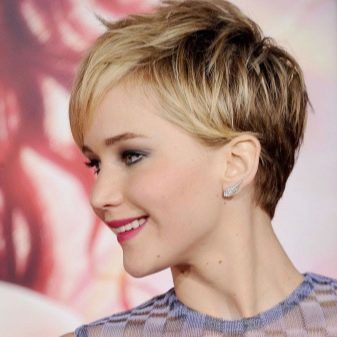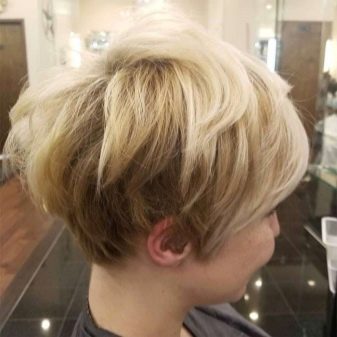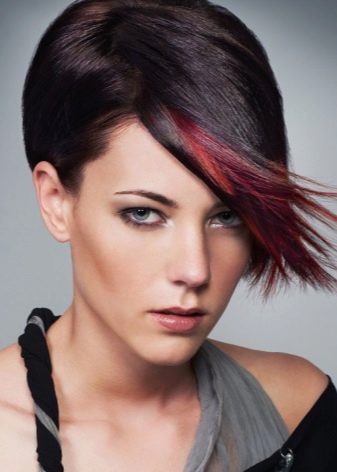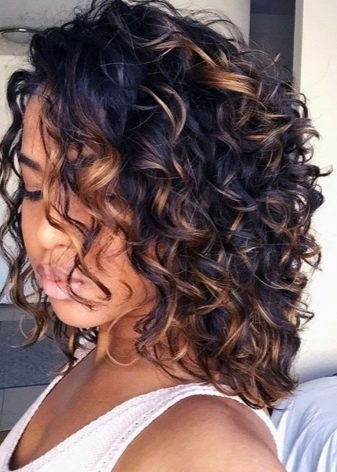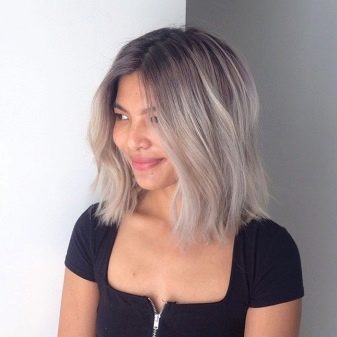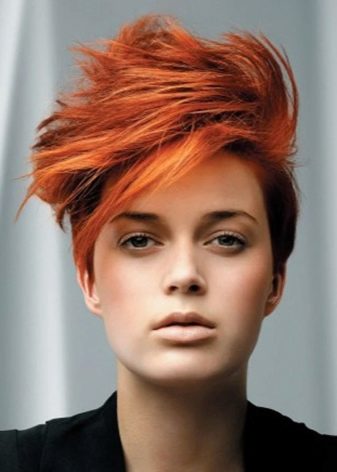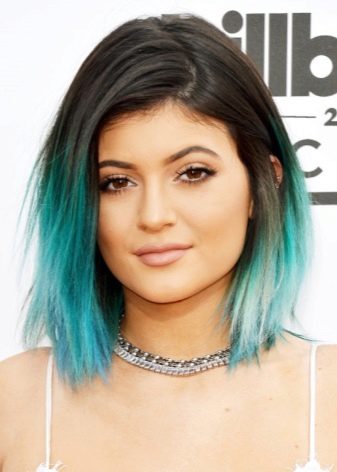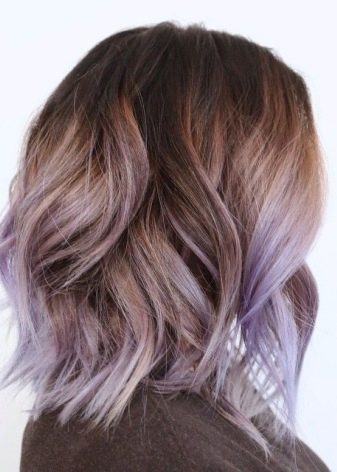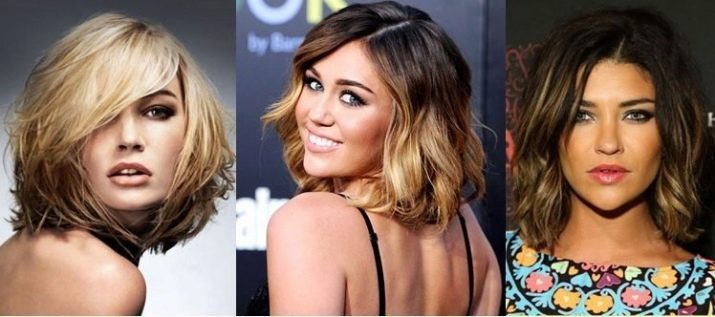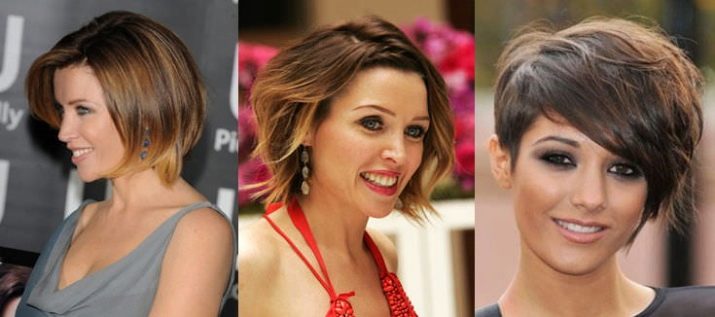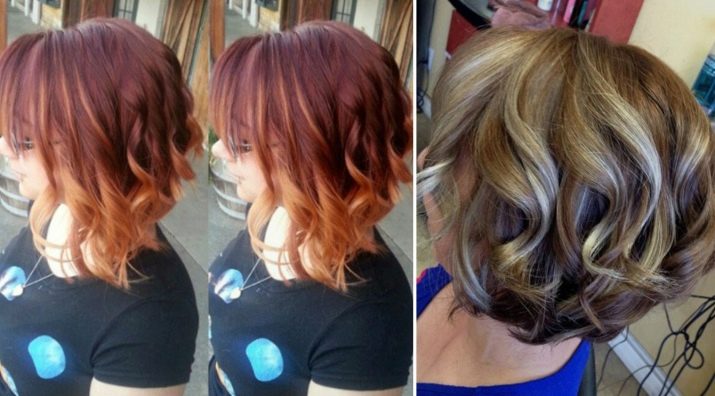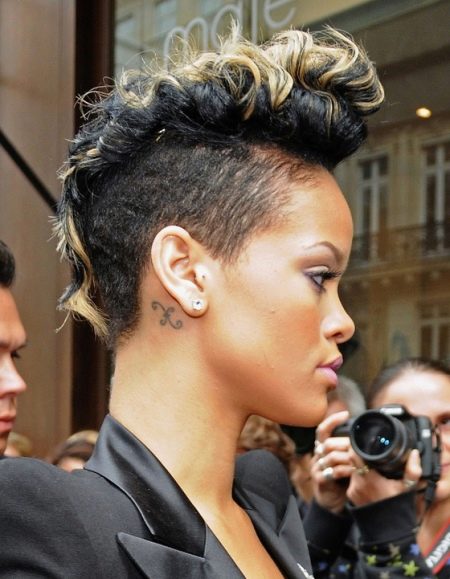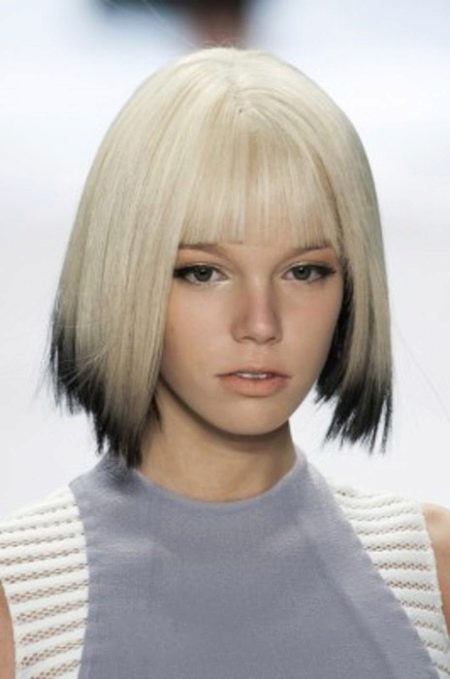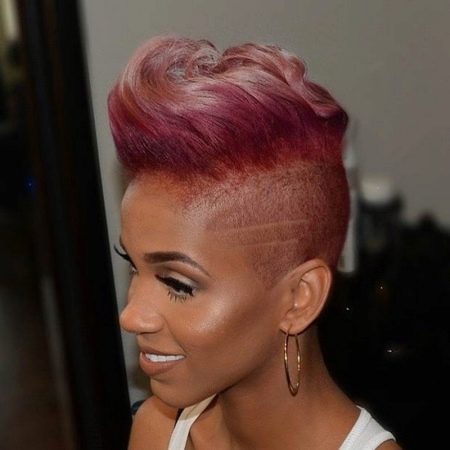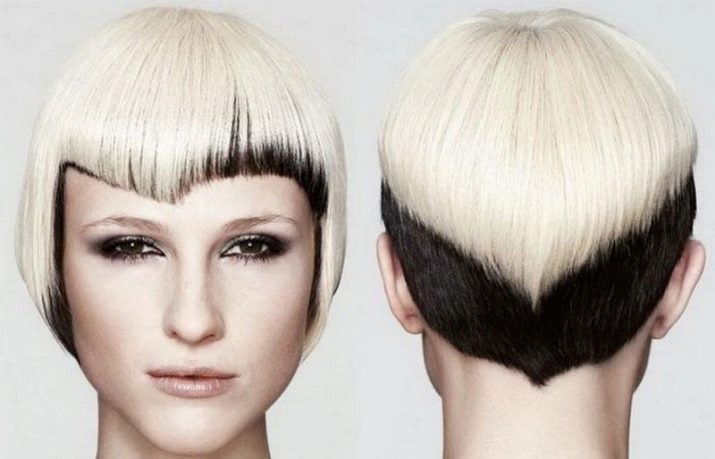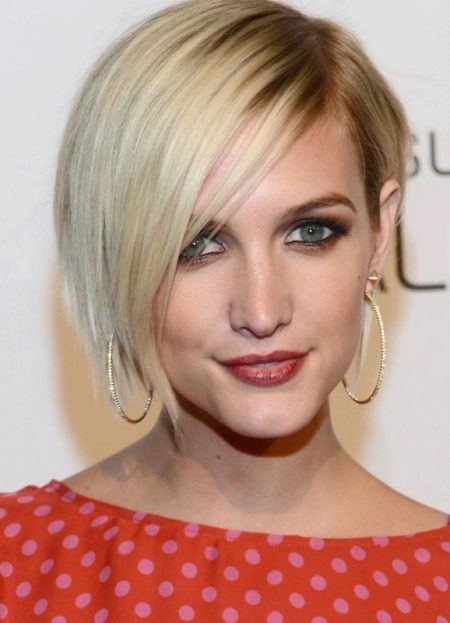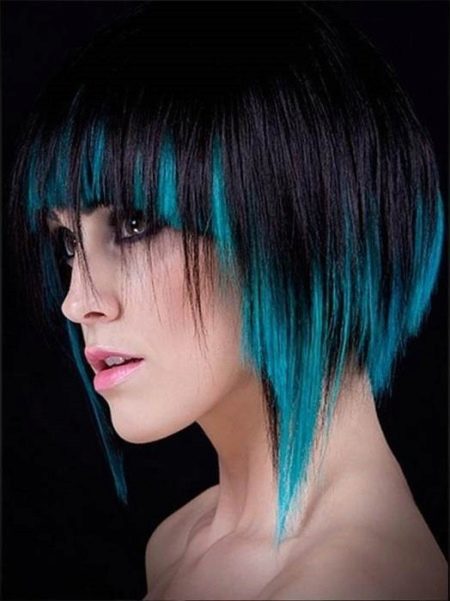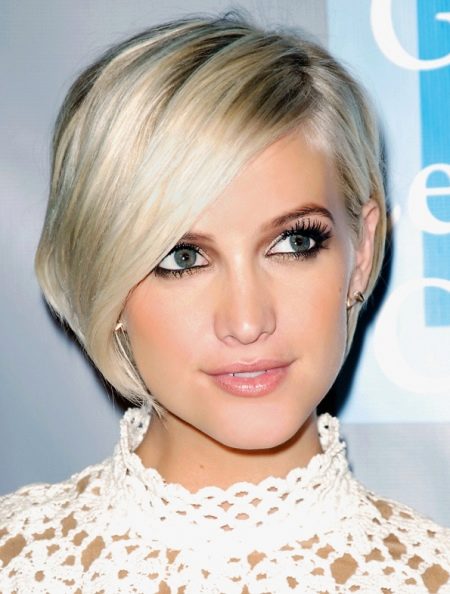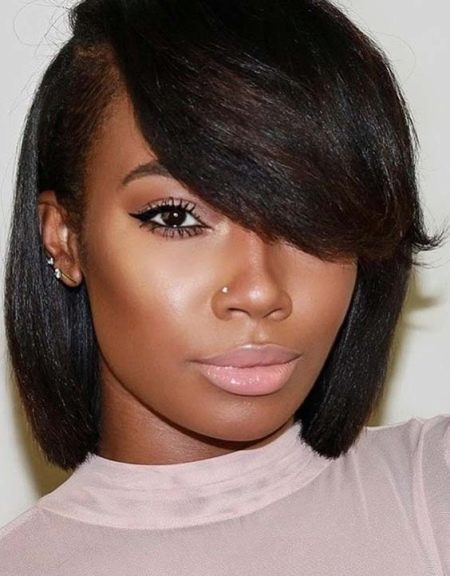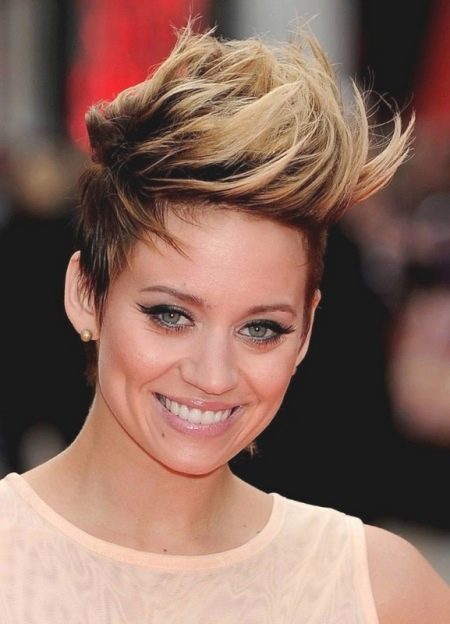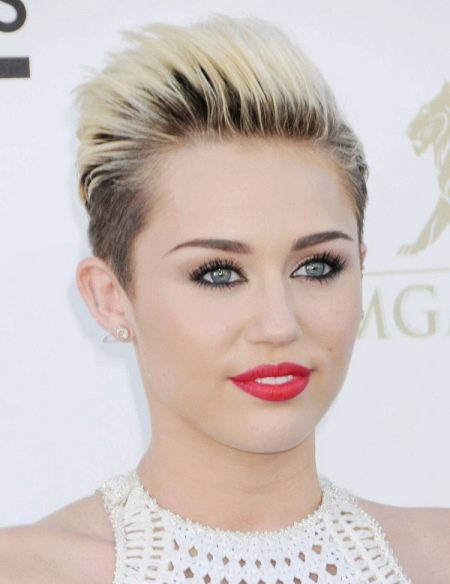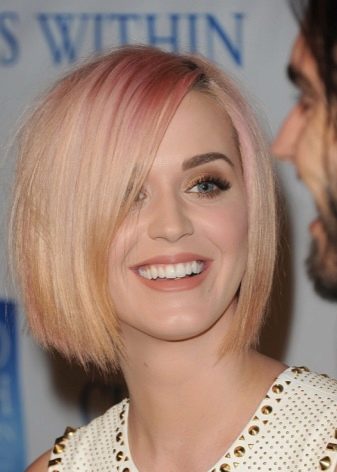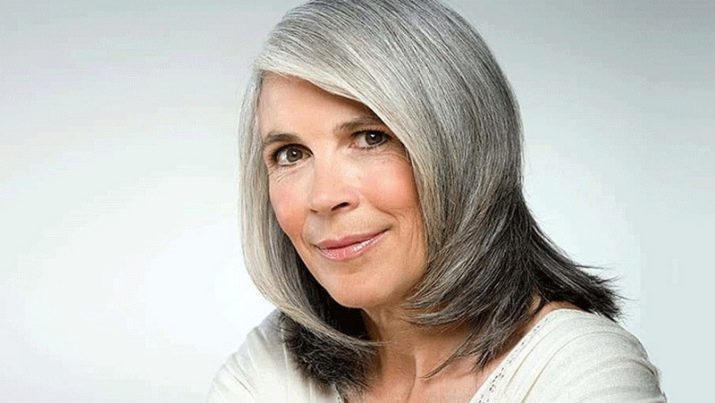The ombre tandem with short strands demonstrates color transitions that give the hairstyle a more rhythmic and lively character. With a short haircut, different shades will definitely be around the face and slightly lower. In this regard, you need to weigh the pros and cons and carefully choose a color for dyeing hair, in harmony with skin color and facial features.
Features
Ombre is a technique of dyeing, not dyeing itself, that is, the very method of applying dyes and the visual effect that is achieved. According to experts, this is a technique of clarification, aimed at partial selection of strands, but, unlike other techniques called balayazh, in the case of an ombre, sharpness and clarity are taboo. The horizontal transition of one color of strands into another is visible, but it is unsharp and indistinct, the line of transition from dark to light is visible, but is blurred.
The task of the ombre is to create a color gradient from the dark area at the base of the hair to the light one at the tips. In the process of applying the color-changing composition on the hair strands combed. The distance from the hair at the roots to the point of a pile is an indicator of the length of the dark area. During this interval, there will be a gradient. The classic version of the ombre technique divides the strands into zones of approximately the same length - into roots, stuffed and ends. Roots are not exposed to brighteners, combed hair mixed with bleached, and the ends are made out as the brightest part.
The word "ombre" from French, one of its meanings is "blackout." The game of shadow and light - the main effect that arises due to this technique. From dark to light from top to bottom, the color flows horizontally from one to another, like the thresholds of a waterfall, and resembles the effect of faded hair in the sun. Ombre is a visual illusion created by certain manipulations and a sequence of actions.
With the help of an ombre, you can work with long hair and with short, with their different forms, use different dyes (from light ones tinting the surface to “heavy artillery” in the form of dyes penetrating deep into the hair and lightening natural pigments) to create the visual effect for which this technique was developed and applied.
The result of the work will depend on the choice of dyes. They will need to be chosen depending on the required degree of lightening when the current hair color changes (2 or more tones) and the height of the colored curls you have chosen in relation to their length (for example, 1/2 of height, 1/3, 2/3) .
The appropriateness of the choice may be dictated by the natural hair color and the degree of exposure to dyes, which you can allow your hair, color type ("winter", "summer", "autumn", "spring"), the state of your curls, as well as your wishes relation to the change of hair color (slightly or radically, naturally or extravagantly - and all intermediate options between these polar ones).
For example, a girl has long hair, she is brown-haired. Her decision is to leave 1/3 of her hair from the roots of a natural color. She chooses a gradient transition to the remaining 2/3 of the hair using three shades. For 2/3 to be painted, she chooses exactly what shades it will be and what color.Depending on this choice, dyes are selected to achieve these shades of color. After this, coloring using the ombre technique begins.
Benefits
Hombre and short haircut is a spectacular duet. Ombre staining makes the necessary accents, emphasizes layers and asymmetry in complex haircuts, creates visual volume and thickness for hair, in some cases thereby eliminating the need for styling.
If you have a desire to return your color, ombre will help to achieve it, bypassing the mandatory haircut of dyed hair. The pattern created using the ombre eliminates the need to remove the entire colored part. It allows you to grow hair gradually, without changing the particular length and will mask them, leaving the opportunity to increase the intervals between staining. The color of your hair while being able to remain attractive and organic.
Ombre technique will help to make an aesthetic transition line. It will remain just to care for your hair and cut only the tips. Yes, and you need to correct the transition only if the border between natural color and colored looks inharmonious. If it turned out that the transition looks smooth, you can leave everything as it is.
disadvantages
A particularly complicating factor is hair length. Short length, especially less than 12 cm, is difficult to create a smooth natural effect. The degree of smoothness will depend on how skillfully the dyes are applied. Either prepare well, either be prepared for any result or consult a colorist. The specialist will be able to evaluate the condition of the hair, and your color type, and select the desired coloring scheme and coloring composition for its implementation.
Growing lines of some haircuts with coloring will require frequent correction, there will be a need to visit the master more often. We must remember this when choosing haircuts and colors. A short haircut with a complex color and gradient will require more attention to maintain it in proper form. Especially if surface dyes will be used to create colors, which will be washed out quickly from the hair surface.
Kinds
As a result of the use of the classical ombre technique, two colors are obtained. One color can be your real one (in the presence of unpainted hair), and the second one is created using dyes. Colors are chosen close to natural. They converge through a conditional horizontal line, intertwining one with another very smoothly.
Within each of the selected colors, due to the techniques used in this technique (for example, by gradually applying and different reaction times of the same dye on different areas of the hair), shades appear that differ in intensity.
Multitonal ombre - these are the same principles of coloring, only embodied with the help of an expanded color gamut. It can be a long filigree stretching of shades within one color or a smooth combination of colors that are next to each other in the color palette through their shades (for example, cognac with copper through a gradient stretch).
In the multi-tonal ombre, the choice can be shifted from natural shades to artificial ones: platinum, purple, lilac, blue, blue, yellow, orange, red, strawberry-pink. The colors can be combined as close in color (from red to yellow through transitional orange), and natural with unnatural (blond and strawberry pink, ash-blond with blue, lilac and blue), delicate natural with pastel artificial, natural with contrasting. It can be a complex gradient with multiple modulations of beautiful shades of its uncommon nature, naturally unnatural hair.
Without preparation, it will be difficult to perform such transitions harmoniously and smoothly, especially on short hair. For self-fulfillment, two-tone staining is more feasible.
For the embodiment of the reverse ombre, everything is done with the exact opposite - white top, bright bottom. It looks very beautiful with dark natural hues of chocolate, coffee, walnut, honey, copper, amber and wheat. Such color pairs are fascinatingly attractive. The combination of a very light shade with pastel amazing strawberry also looks elegant. Contour ombre - an option that is also worthy of attention. If you have made a graduated or complex multi-layered haircut, supplementing its catchy shape with contour ombre is one of the best solutions.
The Scandinavian ombre is ideal for light-eyed and fair-skinned girls. Platinum blonde and black (or brown) tips look impressive in combination. The mood of the Scandinavian ombre also reflects the combination of white with a cold platinum ebb and frosty blue. There may be other options that continue these motifs.
When armored with an ombre effect, a very small portion of the root zone remains darkened, and the rest of the length is painted in lighter shades, which should differ by a maximum of 2-3 shades. The effect of ombre when using this technique is to highlight the tips and perform stretching along the entire length of the hair. But the reservation is different from the ombre by the fact that as a result of the use of the ombra, the smooth but visible horizontal border between tones is visible, and when bronding it is blurred to invisible.
Usually the ombre technique is applied around the entire circumference of the head. If you select a segment and carry out the application of dyes only inside it from dark to light, or vice versa, but with a smooth horizontal transition - this will be a partial Ombre. On a cropped hair, you can select segments closer to the face and dye them only in this technique, leaving the color in the back of the head untouched and uniform. Sometimes several techniques are used to translate a complex pattern.
Ombre with a clear border gives a very beautiful graphic pattern, admiring the master’s professionalism - and the transition is clearly visible, and at the same time, along the horizontal border, colors merge seamlessly through shades of color and halftones. Depending on whether you just want to give vitality to color or to paint in an extravagant style, you can choose either natural shades or delicate artificial, or stronger contrasts - from natural to artificial.
The choice of shade by type of haircut and hair color
The ombre technique achieves excellent results when applied on such types of short haircuts as a bob, bob-bob, bob, cascade, ladder, page, asymmetrical haircuts. At the length of the shoulders, the ombra technique is much easier to implement than with a length of 12-15 cm. Cascade - haircut with a complex structure, with layers. Very practical, fast in laying, volume and easy. The classic version of the haircut - a few layers with an increase in the length of each layer from top to bottom. Cascade and ombra as if made for each other.
The classic cascade is amazing with a two-tone ombre. Cascade with torn ends can be shaded contour ombre. Asymmetrical combine with partial ombre. The charming bob haircut will look even more elegant with the help of the ombre technique. The bob, like the cascade, has many varieties: bob-square, legged bean, asymmetrical bob. Interesting fact: having initially chosen to cut a pixie with an ombra, you can beautifully go with the same pattern of hair to the bob. This is well illustrated by photos of Ashlee Simpson, who wore a pixie before a bob haircut.
Haircut "ladder" - also the perfect companion ombre, especially with the use of red shades. Non-standard stylish pixie haircut becomes even more gorgeous due to the gradient, classic or color. It is good for any age, with almost any characteristics of hair type, structure and color. The exception is heavily curly locks.But if they are thin, playful and adventurous haircut with the help of an ombre will be supplemented with visual volume.
If you have a round face, then the strands at the temples visually correct the oval, lengthen it. But there is one caveat: you need to constantly maintain a haircut visiting a hairdresser and styling. Classic Pixie - the minimum length at the back of the head and any in the area of the crown. Hair near the face is longer than the rest of the hair. Bangs can be both profiled and thick and straight, as well as long and oblique. And it is to the bangs that the partial ombre can be applied. You can arrange the color pattern only on it.
Partial dyeing can be used on other haircuts with bangs. Suitable for an ombra bang or not, depends on its shape. Straight dense bangs should not be dyed in such a technique, and the rest of the hair in a hairstyle with such a bang is better to begin to lighten below its level. Asymmetrical long bangs may become the only colored part of the haircut. Drawing on the bangs can be made light natural shades with the main dark color. You can apply bright color accents using a contrasting color.
Ombre wavy hair looks amazing. A wave is added to the overflow of color, the depth of the effect increases. Unlike wavy hair, on direct merging of shades appears more clearly. Unusual pattern is better seen on a flat surface. For this reason, ombra with complex bright colors look best on straight hair. Straight hair and complex bright pattern - a strong combination.
The brown-haired have shades of chestnut to dark blonde. Chestnut and chocolate brown-haired women with light skin can pay attention to platinum, plum, purple, blue, fiery red or a combination of natural and delicate: coffee, cinnamon, caramel, brandy, nut, beige. On dark blond black hair, an ombre looks enchanting. The dark background of the hair is set off by the ombre-dyed hair, not only when choosing bright colors, but also when choosing natural ones. Brunettes can dye their hair in ashy color, so a powerful beautiful contrast will be achieved.
To lighten dark hair, the dye must get deep into the hair, react with the pigments and lighten or even discolor them. The tips can be tinted in dark and delicate artificial shades. You can tint the root zone.
By the natural brightness of red hair ombre technique can join delicately and elegantly. When auburn color can make the tips lighter: delicate copper, gold, natural, and light red hair tinted on the tips in the darker: chestnut, cognac. Or from natural hair go to artificial red or toned roots in the dark, leaving the natural color on the rest. One caveat: in this case, the roots will need to tint regularly.
In gray hair there is almost no natural pigment, and the dye needs a reaction with natural pigment, so not all dyes on gray hair fall. For gray hair you need a tool with a special marking that it is suitable for them. Because of this specificity, it is better to dye gray hairs at a specialist or at least to consult which dyeing means are right for you. If you have 100 percent gray hair - this is an excellent base for a reverse ombre on natural hair, which you can try to do yourself by stretching the dark color at the tips.
How to choose by type of face and eye color?
When you have chosen the dyeing technique and color, evaluate how they are right for you according to the characteristics of the hair, the color of your eyes and skin, its condition. In the case of a short hairstyle, the color will decorate, smooth or, on the contrary, emphasize (in case of unsuccessful choice) what we would not like. The easiest way is to match the color to the eye color: blue-eyed - light and cold shades, green-eyed - warm shades of copper, brown-eyed - red and chestnut. But in the perception of the overall picture, the color of the skin, the original hair color play a role, therefore it is better to study your color type.
Many people like the captivating cold ash ombra, but the “winter” color type is best suited. Scandinavian Ombre - original version for light-skinned and light-eyed. The variant with white tips and strawberry at the roots is well combined with both a light cold skin tone and a warm peach color. The dark color also combines well with the “pink gold” tone.
How to care?
Before dyeing, it is necessary to start caring for 2-3 weeks to prepare the hair for contact with coloring matter, to minimize trauma to the hair during styling and drying. If your hair is already colored, you need to use shampoos adapted for dyed hair. Before leaving for the sea and the sun you need to take protective equipment from the sun's rays.
Hair care after lightening, especially at the tips, should be very careful and careful. If dyes were applied only to the ends of the hair and the problem of root regrowth is absent, then You can re-paint them after 3 months, or even after 4. If a haircut requires - more often.
With folk remedies for dyed hair, you need to be very neat - by reacting with artificial pigments, they can spoil the hairstyle. Professional cosmetics created taking into account the reactions and has already been tested. If you are determined to act independently and do an ombre with your own hands, you can do the haircut and dyeing in the salon for the first time, watch the process, assess its complexity, and either continue to visit the master, or just do the haircut at him, and practice at home .
Beautiful examples
- Classic ombre on short hair.
- Extravagant two-tone ombre on the Iroquois.
- Virtuoso smooth transition from white to black ends through beige, cocoa and coffee, made just a few centimeters.
- The most complex multitonal red-pink ombre on the mohawk.
- Reverse ombre: white and strawberry.
- Contoured ombre delicately highlighting layers of hair.
- Cinnamon roots and play of blond on an asymmetrical car.
- Extravagant partial ombre.
- Soft cascade and two-tone ombre.
- Platinum bob and armor with an ombre effect.
- Rack and Ombre on dark hair.
- A two-tone classic ombre on a pixie haircut.
- Stunning delicate gradient on bangs.
- The perfect gradient on the car with straight bangs.
- Amazing ash ombre on dark hair.
- Double ombre and mischievous styling on short hair.
- Toned in strawberry roots with mostly blond on a bob haircut.
- Bob square with darkening on the tips.
- Reverse ombre and short haircut on natural gray hair.
How to make an ombre for short hair, see the following video.



